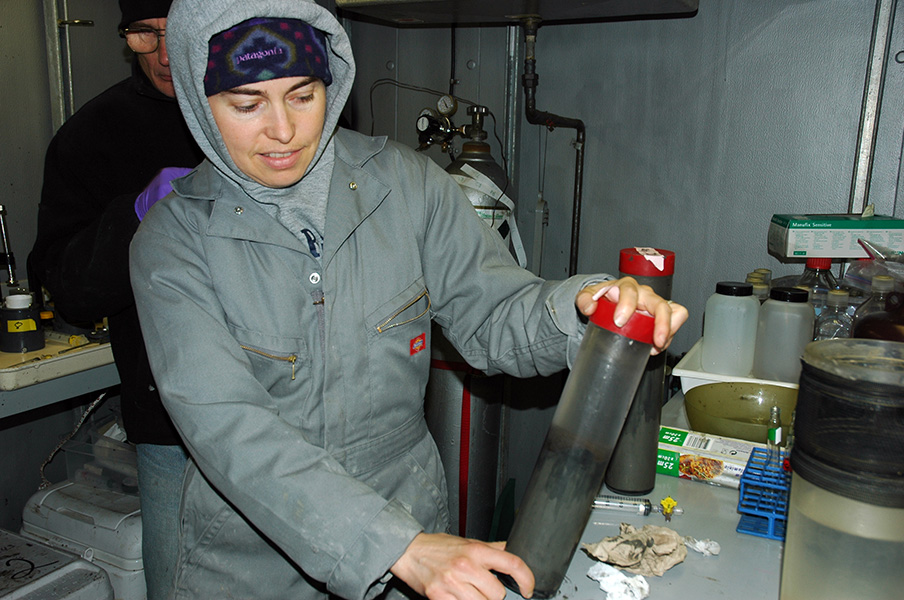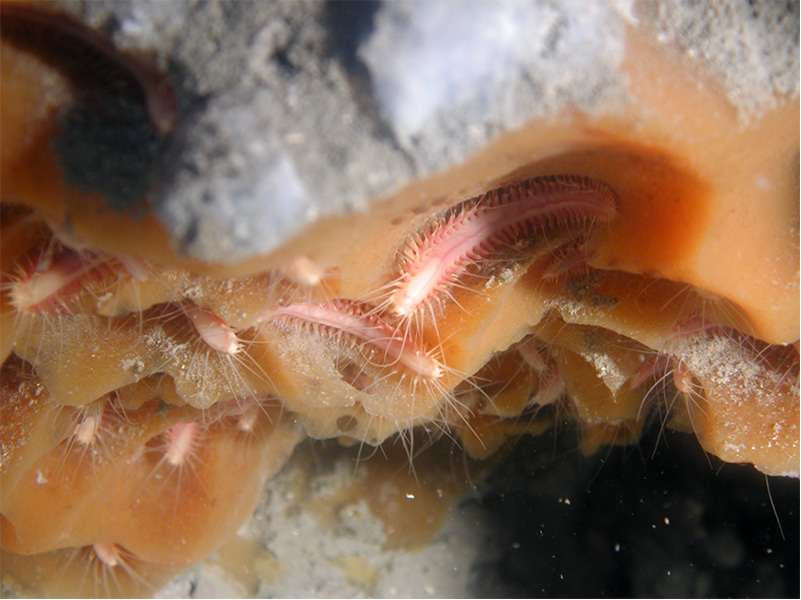In the early morning of April 21, 2010, oceanographer Samantha Joye received a troubling email from a research partner out at sea in the Gulf of Mexico. What should have been a routine trip to collect water and sediment samples from the seafloor had, instead, turned into a disaster scene: Plumes of smoke billowed in the distance, her colleague wrote, and Coast Guard boats were hightailing it past their research vessel. They returned to port, and a knot formed in Joye’s gut that would persist for months to come.
The team soon learned that a BP oil rig called Deepwater Horizon had just exploded, resulting in the deaths of 11 oil workers and precipitating the largest-ever accidental marine oil spill as more than 200 million gallons of toxic petroleum were left to swirl through the gulf.
It was also the deepest-ever oil spill, much of it emanating from a wellhead located nearly a mile down, on the seafloor. In the days after the explosion, Joye worried that large volumes of oil and gas remained trapped at depth, surging within deep-sea currents. And she knew that finding this plume would be critical to its eventual cleanup. So she urged her team to repurpose upcoming ship time, meant for more routine sample collection in the gulf, to track down that plume — not an easy pivot for oceanographers used to planning research cruises years in advance. “Fly-by-the-seat-of-your-pants ocean science is just not something that is done,” Joye says.
Her team was right to change tack. In the following weeks, they became the first to locate a massive river of pollutants as it wound between deep-sea knolls and blanketed currents with benzene, toluene and other known carcinogens and neurotoxins found in crude oil and gas. That meandering underwater plume contained more than half of all the material released during the 87-day blowout, invisible to the satellite imaging that surveyed the spill from above. If it had only been assessed with surface slicks, “half of the oil and all of the gas would have been unaccounted for,” Joye says.
That brew of toxins would go on to harm or kill hundreds of thousands of animals in the years to come, mutilating the livers of seabirds, the lungs of dolphins and, it’s thought, the skin of fish. Now, more than a decade later, much of the material has broken down, but some persists within ocean sediments. Joye leads a consortium of researchers that has continued to monitor these environmental impacts, one of several projects she pursues out of her lab at the University of Georgia.
More broadly, Joye specializes in the unique metabolisms of marine bacteria that feed on oil and gas — an area of study that has helped to shape debates about how best to leverage these bacteria to clean up spills. She’s drawn to these microbes, she says, not just for their capacity to remedy disasters but also for their role in stabilizing the planet’s climate by consuming greenhouse gases. She’s now looking at how these microbial communities and their numerous environmental services may shift or suffer in a warming world.
Joye approaches her work with a rigor and charisma that has often landed her in the public sphere, including participation in the BBC documentary Blue Planet II, consulting work on an educational video game, and collaboration on a kids’ cartoon. She carves out more time than is typical for such education and outreach because, she says, she views reaching young people and helping to inspire the next generation of marine scientists as a sort of insurance policy for the future of the ocean.
Her microbial expertise and explorations reach beyond the marine realm, into lakes, mangroves and estuaries — lending her a scope of knowledge that attracts colleagues to work with her, and has earned her a roster of nods and awards in her 30-plus-year career. “She’s made really exceptional contributions,” says Beth Orcutt, a geomicrobiologist who studied with Joye as a graduate student more than a decade ago and now researches marine microbes at the Bigelow Laboratory for Ocean Sciences in East Boothbay, Maine. While many microbiologists orchestrate their careers around a single organism or system, Joye’s broader focus allows her to take a more well-rounded approach and more easily figure out potential problems or biases in her findings, Orcutt says. “This is why I think she’s so respected in the field.”

Joye (back left) in a submersible, exploring the seafloor of the Gulf of Mexico. The gulf is where she has conducted most of her numerous dives to the bottom of the ocean.
CREDIT: PHOTO BY MARK TAYLOR
Roots of an ocean explorer
Though she’s loved the ocean since childhood, Joye didn’t grow up wanting to be an oceanographer. Her family grew soybeans, cotton, tobacco and other crops on a farm in South Carolina, and she went to the University of North Carolina at Chapel Hill in 1983 with plans to become a doctor. But she took a marine science course on a whim during her junior year and found herself hooked and excelling. The professor of that course wrote her a letter urging her to consider graduate school, and she took that suggestion to heart. “He lit a fire in my imagination, and I was able to focus all my intellectual energy and curiosity on asking questions about the oceans,” she says.
She went on to earn a master’s and a PhD in marine sciences from North Carolina and then landed a postdoctoral position at San Francisco State University in 1993, studying communities of marine microbes called methanotrophs — “methane eaters” that help to stabilize Earth’s climate by consuming that potent greenhouse gas. That year, she attended a session at a conference about similar microbes that inhabit the deep sea; when she approached one of the speakers with questions, the result — to Joye’s surprise — was an invitation to join an upcoming research cruise to the Gulf of Mexico. The 1994 trip brought her down to the seafloor for the first time and became the catalyst for much of her work thereafter.

Joye on board the research vessel R/V Atlantis in 2006, examining a sediment core that her team collected to study microbial activity on the seafloor.
CREDIT: PHOTO BY JEREMY POTTER
Since then, Joye has led or participated in well over 100 trips to the bottom of the ocean, many in the Gulf of Mexico; she attributes her needle-in-a-haystack luck of finding the submerged oil and gas from the Deepwater spill to the many hours she spent cruising there. As she navigates the underwater canyons and volcanoes of that terrain, she takes troves of photographs and video footage, and uses robotic arms and baskets to collect samples of water, rock and microbial mats that she brings back to the lab for analysis.
She fills notebooks with thoughts as she descends, often formulating new research questions in the moment. “There’s this burst of creativity and awareness that I have never gotten any other way that I get when I’m in a submarine,” she says. If it weren’t for her three adolescent children, she adds, she’d want to sink to the bottom of the ocean every day.
When down there, she often navigates to structures called hydrocarbon seeps, where oil and gas naturally spew out of fissures in the seafloor and support an unexpectedly lush oasis of mussel beds, giant six-foot-long tube worms and unique communities of bacteria with a strong appetite for oil and gas. Over the years, she has explored how these microbial communities share and compete for resources and has been surprised to find just how often the waste of one organism serves as a food source for another, so that different species coexist cooperatively in their remote deep-sea environments.
Her intimate knowledge of these microbes and environments, which she details in an article in the Annual Review of Earth and Planetary Sciences, helped her to critically assess the controversial use of chemical dispersants to clean up the Deepwater Horizon spill in the years following the disaster. She wondered whether the application of these detergent-like chemicals — which break oil into tiny droplets that are easier for microbes to consume — might attract bacteria more inclined to feast on the dispersant itself than the oil, and potentially even push away the oil-centric microbes. If this were the case, more oil would remain in the ocean than if no dispersant were applied at all.

Methane ice worms are among the many unique creatures that dwell within the hydrocarbon seep environments that Joye studies on the seafloor.
CREDIT: ECOGIG AND DR. IAN MacDONALD
For the Deepwater Horizon disaster, this consideration wasn’t trivial: An unprecedented 7 million liters of dispersant ended up in the Gulf of Mexico following the spill, initially in an inefficient firehose-type application, Joye says. She and colleagues have since conducted laboratory studies that have shown that the dispersant can, indeed, slow oil degradation by promoting the growth of dispersant-eating microbes and suppressing the oil-eating ones. She says it’s still unclear whether, when and how best to use dispersant, but she urges the marine science community to consider these nuances in future spill assessments.
“Her work on that has been state of the art,” says Claire Paris-Limouzy, an oceanographer at the University of Miami who has worked with Joye to assess the persistence of oil — dissolved and difficult to track — in the gulf to this day. As deep-sea oil exploration continues to expand around the world and perpetuate the risk of more deepwater spills, Paris-Limouzy says, it’s crucial to understand how these spills emanate underwater and how best to clean them up.
Such work doesn’t come without its challenges. Collecting samples amid the oil slick in the weeks after Deepwater Horizon required donning full-body hazmat suits in 105°F weather and inhaling benzene and other noxious fumes on a ship whose air filtration regularly malfunctioned due to oil clogging the water intakes. “It was pretty terrible conditions to work in,” Joye says.
But now, a decade later, those efforts have laid important groundwork for understanding how marine microbial communities help to keep the ocean healthy. Joye is currently exploring whether stressors such as the increased water temperature and acidity associated with climate change shift the collaborative nature of these ecosystems and make them more competitive, favoring one organism over another — and how imbalances she finds may, in turn, influence other ocean systems.
And she continues to intensify her outreach with youth, recently establishing an ocean discovery camp for middle-school students in Georgia. She plans to follow her campers in the years to come, in hopes of supporting some to pursue lifelong careers in ocean science.
“Getting these kids engaged and firing up their passions now is something that I think is just critically important,” she says. “It’s important for the future of everybody.”




